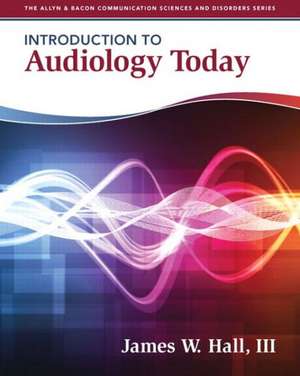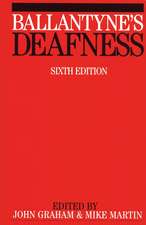Introduction to Audiology Today: Allyn & Bacon Communication Sciences and Disorders
Autor James W. Hallen Limba Engleză Paperback – 7 iul 2013
An up-to-date introduction to the profession of audiology, Introduction to Audiology Today is written to stimulate the student’s interest and excitement in audiology or speech-language pathology as a career choice. Chapters on hearing science covering essential information about sound and auditory anatomy/physiology include helpful figures and readable explanations of recent research findings. Current behavioral and objective procedures and strategies for hearing assessment of children and adults are described and consistently related to clinical audiology practice. Two chapters are devoted to a readable and up-to-date review of the diverse etiologies underlying peripheral and central auditory dysfunction, including auditory neuropathy spectrum disorder and auditory processing disorders.The text is enhanced with an assortment of high quality digital photographs illustrating the tools and technologies used by audiologists in clinical practice.
Preț: 1151.70 lei
Preț vechi: 1212.32 lei
-5% Nou
Puncte Express: 1728
Preț estimativ în valută:
220.43€ • 237.94$ • 184.83£
220.43€ • 237.94$ • 184.83£
Carte disponibilă
Livrare economică 28 martie-11 aprilie
Preluare comenzi: 021 569.72.76
Specificații
ISBN-13: 9780205569236
ISBN-10: 0205569234
Pagini: 566
Dimensiuni: 203 x 251 x 15 mm
Greutate: 0.92 kg
Editura: Pearson
Seria Allyn & Bacon Communication Sciences and Disorders
ISBN-10: 0205569234
Pagini: 566
Dimensiuni: 203 x 251 x 15 mm
Greutate: 0.92 kg
Editura: Pearson
Seria Allyn & Bacon Communication Sciences and Disorders
Notă biografică
James W. Hall III received a Bachelor's degree in Biology from American International College, a Masters degree in Speech Pathology from Northwestern University and, in 1979, his PhD in Audiology from Baylor College of Medicine under the direction of Dr. James Jerger. Since then, he has held clinical, administrative, and academic audiology positions at major medical centers including the University of Pennsylvania, the University of Texas Medical School-Houston, Vanderbilt University and the University of Florida. Throughout his career, Dr. Hall has maintained a clinical practice and conducted funded research. He's also served as a clinical instructor and mentor in Doctor of Audiology and PhD programs. He now holds an appointment as Extraordinary Professor in the Department of Communication Pathology at the University of Pretoria in South Africa and adjunct faculty positions at multiple universities in the USA. Dr. Hall is a Founding Member of the American Academy of Audiology and serves on many professional committees, task forces, and editorial boards. He regularly gives workshops, seminars, and lectures throughout the United States and internationally on diverse audiology and hearing-related topics. Dr. Hall is the author of over 150 professional publications, including popular textbooks such as the New Handbook of Auditory Evoked Responses, Audiologists' Desk Reference (Volumes I and II), Objective Assessment of Hearing, and Otoacoustic Emissions: Principles, Procedures, and Protocols. Additional background information about Dr. Hall is available on his website: www.audiologyworld.net.
Cuprins
Part 1: Profession and Principles of Audiology
Chapter 1: Audiology Yesterday, Today, and Tomorrow
Chapter 2: Sound, Acoustics, and Psychoacoustics
Chapter 3: Anatomy and Physiology of the Auditory and Vestibular Systems
Part 2: Audiology Procedures and Protocols
Chapter 4: Preparing for Hearing AssessmentChapter 5: Pure Tone Audiometry
Chapter 6: Speech Audiometry
Chapter 7: Masking and Audiogram Interpretation
Chapter 8: Electro-Acoustic Measures
Chapter 9: Special Speech Audiometry Tests and Auditory Evoked Responses
Chapter 10: Differential Diagnosis of Auditory and Vestibular Disorders
Part 3: Patient PopulationsChapter 11: Outer, Middle, and Inner Ear Disorders
Chapter 12: We Hearing With Our Brain: Retrocochlear and Central Nervous System Dysfunction and Disorders
Part 4: Audiologic Management Technology and Techniques
Chapter 13: Audiologic Habilitation/Rehabilitation: TechnologyChapter 14: Audiologic Habilitation/Rehabilitation: Techniques
Chapter 15: Pseudohypacusis, Tinnitus, and Hyperacusis
Chapter 16: Management Strategies in Specific Patient Populations
Chapter 1: Audiology Yesterday, Today, and Tomorrow
Chapter 2: Sound, Acoustics, and Psychoacoustics
Chapter 3: Anatomy and Physiology of the Auditory and Vestibular Systems
Part 2: Audiology Procedures and Protocols
Chapter 4: Preparing for Hearing AssessmentChapter 5: Pure Tone Audiometry
Chapter 6: Speech Audiometry
Chapter 7: Masking and Audiogram Interpretation
Chapter 8: Electro-Acoustic Measures
Chapter 9: Special Speech Audiometry Tests and Auditory Evoked Responses
Chapter 10: Differential Diagnosis of Auditory and Vestibular Disorders
Part 3: Patient PopulationsChapter 11: Outer, Middle, and Inner Ear Disorders
Chapter 12: We Hearing With Our Brain: Retrocochlear and Central Nervous System Dysfunction and Disorders
Part 4: Audiologic Management Technology and Techniques
Chapter 13: Audiologic Habilitation/Rehabilitation: TechnologyChapter 14: Audiologic Habilitation/Rehabilitation: Techniques
Chapter 15: Pseudohypacusis, Tinnitus, and Hyperacusis
Chapter 16: Management Strategies in Specific Patient Populations
Textul de pe ultima copertă
Introduction to Audiology Today is a contemporary and clinically oriented review of information traditionally found in an introductory audiology book used by undergraduate students. An up-to-date introduction to the profession of audiology, Introduction to Audiology Today is written to stimulate the student s interest and excitement in audiology or speech-language pathology as a career choice. Chapters on hearing science covering essential information about sound and auditory anatomy/physiology include helpful figures and readable explanations of recent research findings. Current behavioral and objective procedures and strategies for hearing assessment of children and adults are described and consistently related to clinical audiology practice. Two chapters are devoted to a readable and up-to-date review of the diverse etiologies underlying peripheral and central auditory dysfunction, including auditory neuropathy spectrum disorder and auditory processing disorders. The final section of the book introduces students to the various technologies and techniques now available for effective management of hearing loss and related disorders such as tinnitus, hyperacusis, and vestibular disorders. The text is enhanced with an assortment of high quality digital photographs illustrating the tools and technologies used by audiologists in clinical practice. This First Edition
- Encourages readers to grapple with the concepts and ideas of the audiology profession. The book incorporates discussions of the latest advances in hearing science and clinical practice.
- Promotes successful application of concepts. Clinical Connections relate the material to the assessment and management of hearing loss in children and adults
- Stimulates deep reflection and application of learning. The book features many figures and original high quality digital photographs to further explain and enhance the written text.
- Provides expertise from the field. The author is an experienced and licensed audiologist who regularly provides services to pediatric and adult patients in varied clinical settings. The Leaders & Luminaries showcases other audiology experts.
- Frames the concepts. Each chapter begins with a concise Chapter Focus that orients the student to topics covered in the chapter.
- Explores further content. WebWatch feature highlights Internet sources of current information on the topic(s) covered in the chapter, including videos showing hearing tests or treatments.
- Enables self-assessment of learning. Each chapter ends with a Pulling it All Together feature summarizing topics that were covered in the chapter.
- Highlights rationale and trends. Book covers how audiologists assess hearing and manage hearing loss and also emphasizes the reason for the diagnostic and rehabilitative procedures and strategies.









